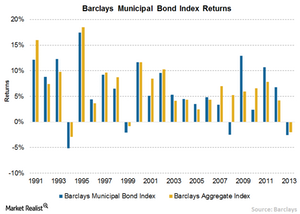Yield Is the Workhorse of Municipal Bond Returns
Over the years, average returns from municipal bonds (CMF) are in line with the broader index. They outperformed in some years and underperformed in others.
June 13 2016, Published 3:48 p.m. ET

Income workhorse
If it’s income you seek, a look at the performance composition of the Barclays Municipal Bond Index also reveals municipal bonds to be a good proposition. Income (or coupon return) delivered more than 90% of the index’s positive performance from 2000 to 2015. Price return accounted for less than 10% of the index’s total return during that period. Income was able to help offset incidents of price deterioration.
Market Realist – Income from municipal bonds
The total return from municipal bonds (MUB) is the yield plus price appreciation over the period of the bond. The bond yield, which is the annualized return of the bond, depends on various factors. But there are three major factors that influence yields: the bond’s acquisition price, the interest rate as stated in the bond’s indenture, and the amount paid at maturity.
The price of the bond has an inverse relationship with prevailing interest rates. When interest rates are rising, existing bond values decline. Falling interest rates increase bond values. Net income is even higher when you take the overall lower taxes into account.
The above graph shows how municipal bonds (SUB), as represented by the Barclays Municipal Bond Index, performed compared to the broader fixed-income market (IEF), represented by the Barclays Aggregate Index.
As you can see in the graph, over the years, average returns from municipal bonds (CMF) are in line with the broader index. They outperformed in some years and underperformed in others. However, since 2009, municipal bonds have provided higher returns compared to the Barclays Aggregate Index. As we’ve already seen, 90% of the indexes’ positive performances was derived from higher yield, while the rest was from price appreciation.
